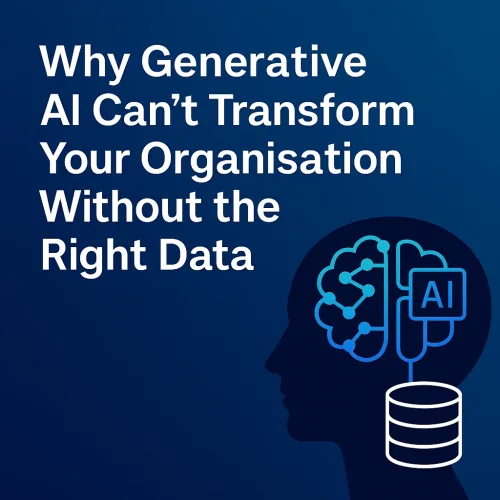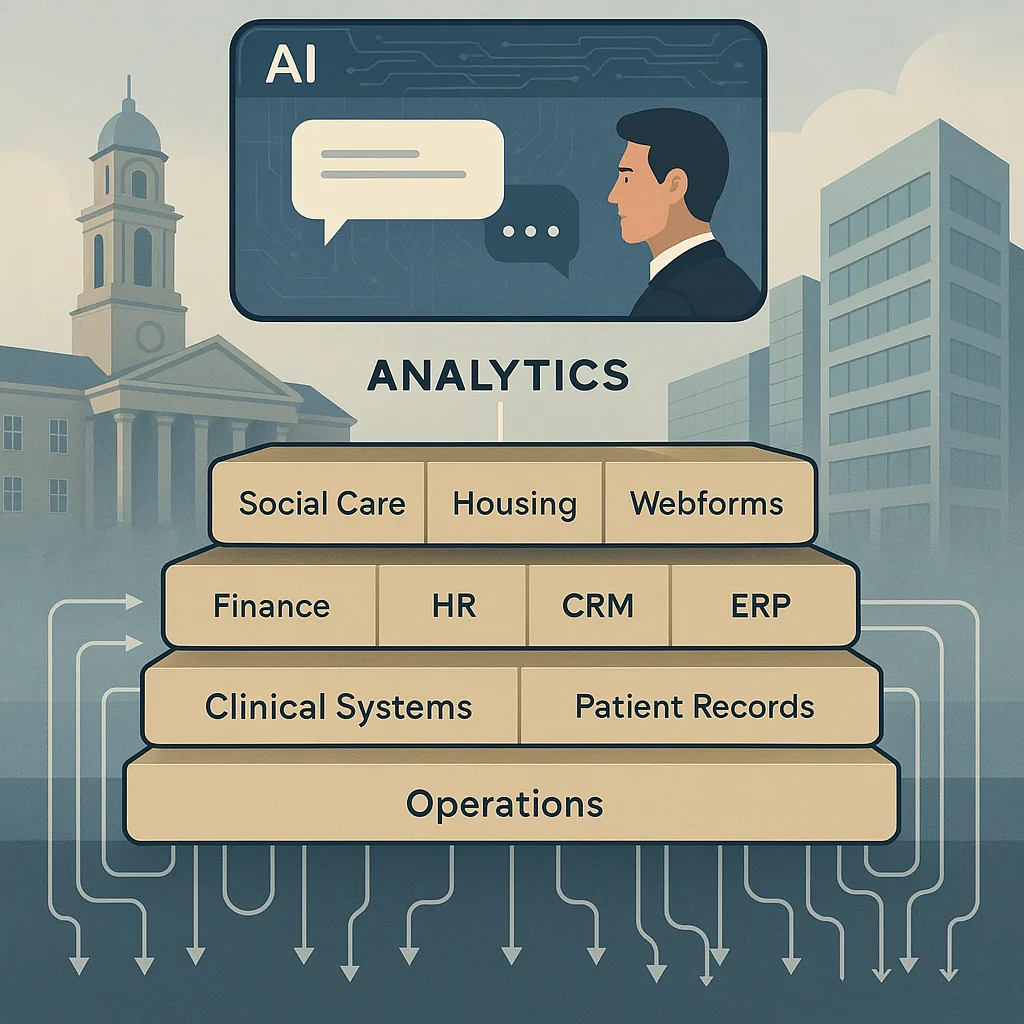
Why Generative AI Can’t Transform Your Organisation Without the Right Data
We’re living in a moment of enormous promise. Generative AI — with its ability to compose, advise, summarise, and assist — is creating bold new possibilities across the public and private sectors alike. But amid the excitement, a crucial truth remains: AI is only as powerful as the data it’s built on.
At itelligent-i, we’ve spent over a decade helping organisations make their data meaningful, secure, and actionable. And we believe that for AI to deliver value — particularly for large, complex organisations — it must be built on foundations you already trust.
Data Fuels Both Decisions and Intelligent Outputs
For years, data has been the backbone of decision-making through dashboards, KPIs, performance reports, and analytical insight. Generative AI doesn’t replace any of that — it complements it.
By drawing on well-formed, curated, secure local data, generative AI can support your team by drafting reports, creating internal communications, proposing administrative suggestions, or streamlining departmental workflows — all grounded in the same trusted data that powers your analytics. It depends on the same rigorous data processes, transformation logic, governance, and modelling principles that underpin your organisation’s analytics development.
In other words, one trusted data asset, curated by a skilled corporate function, can now serve both decision-makers and AI — without duplicating platforms or compromising control.
AI Is the New Interface — But Data Is Still the Engine
Over the past 10+ years, itelligent-i has worked with councils, service providers, and public sector leaders to manage complex, relational datasets that reflect the nuance and reality of how services operate.
From social care to housing, performance management to citizen outcomes, we understand how data mirrors the real world — and how to model that effectively in a platform.
We’ve built and governed data platforms that reflect real processes, not just dashboards. And now, we’re using those same trusted models to power AI — safely and at scale.
As KPMG notes, “converting your data into an asset to extract value from is an enterprise-wide job” — a principle that underpins itelligent-i’s approach to unifying data, governance, and AI enablement.
Secure, Governed, Fit-for-Purpose — by Design
Whether powering analytics or enabling AI, your data needs to be:
- Secure – protected against unauthorised access and used responsibly
- Governed – with clear roles, controls, and data quality baked in
- Fit-for-purpose – structured around the real questions leaders are trying to answer
This is where itelligent-i’s Cloud Data Platform and Data Framework come in — ensuring every dataset, whether for human decision-makers or AI-powered tools, meets the highest standards for trust and usability.
Gartner cautions that “flashy AI capabilities are meaningless if built on unreliable data.” Trustworthy insight depends on strong foundations — which is why governance is embedded into everything we do.
One Trusted Data Platform — Powering Analytics and Generative AI
Generative AI can deliver meaningful benefits across large, complex organisations — and itelligent-i can deploy it as a standalone capability or as a complement to your existing analytics strategy. What makes our approach unique is that both AI and analytics are built on the same secure, governed cloud data platform and Data Framework.
That means:
- One platform to support and maintain
- A single source of the truth
- Fully governed, trusted data
- Reduced infrastructure complexity and cost
Whether you’re generating briefing documents, creating service summaries, drafting correspondence, or prompting AI to interpret local performance data — every output is shaped by the same trusted data foundations. Human approval remains built in to itelligent-i’s methodology, ensuring quality, compliance, and confidence.
Gartner predicts that by 2028, 80% of generative AI business applications will be developed on existing data management platforms — reinforcing our strategy of one unified data architecture for both analytics and AI.
AI with Human Oversight — By Design
AI outputs should support human decision-making — not replace it.
That’s why our methodology is aligned with the UK Government’s Ethics, Transparency and Accountability Framework for Automated Decision-Making. It states that “human oversight is critical when automated outcomes affect people directly.” At itelligent-i, this principle is non-negotiable.
Every generative AI use case we deliver is governed by a human-in-the-loop model, ensuring that draft outputs are reviewed, validated, and approved — especially when they relate to citizens, clients, or front-line services.
Analytics and AI: Partners in Progress
The promise of generative AI isn’t in novelty — it’s in performance and productivity. The organisations that benefit most will be those who’ve already invested in reliable analytics foundations — and now want to extend those investments into intelligent automation, assisted drafting, and accelerated decision cycles.
Bain & Company reports that while over 87% of organisations are piloting or using generative AI, data readiness, governance, and platform integration remain the biggest barriers to sustained value.
With over a decade of experience in building secure, scalable, and strategic data platforms — and in delivering meaningful, actionable insight from the complex data within them — itelligent-i is uniquely positioned to help large, complex organisations move confidently into the AI era.
Because true intelligence doesn’t come from an algorithm alone. It comes from trusted data, expert people, and technology working together.




